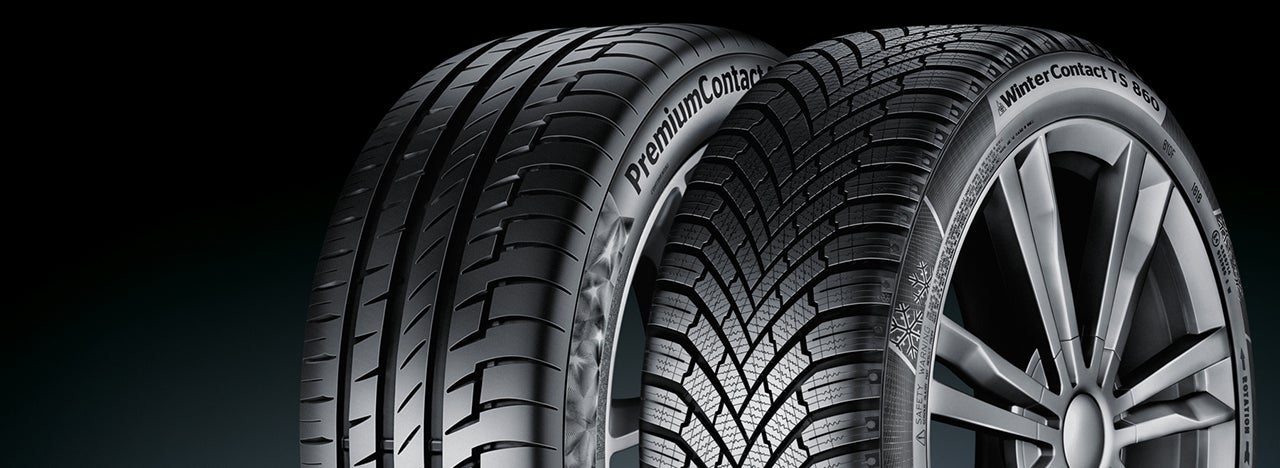
# Tire Change and Fitting
Winter tires in summer
Why you shouldn't drive on winter tires in the summer months
In this section, we will explain why driving on winter tires in the summer months is a bad idea. The reasons are quite compelling, and we're sure you'll agree.
There are good reasons why winter tires are so indispensable in winter. They're made from specialized, flexible rubber compounds and feature unique tread designs to deliver the best grip in snowy and icy road conditions. They function at their best in cold temperatures and winter precipitation, providing confidence and security to drivers in potentially hazardous situations.
But while such tires are the undisputed champion when it comes to colder climates, those same features put them at a disadvantage if used in warmer temperatures. A dry road without ice or snow doesn't need tires biting edges to provide traction.

1. Winter tires don't like warm roads
The softer tread of a winter tire wears out a lot quicker on warm tarmac. It’s the rubber compound, which is formulated to stay soft and pliable when temperatures plummet below 7 °C (46 °F).
It’s very effective for mitigating the negative impact of cold temperatures and provides traction in winter conditions.

But if you run a set of winter tires throughout the year, that same flexible tread will wear down more quickly in warmer temperatures. It reduces the service life by as much as 60 percent. There’s a strong chance you’d have to replace them earlier than if you’d simply remove them at the beginning of spring.
Our recommendation for hot weather is to use all-season or summer tires. Summer tires are manufactured with a different blend of rubber designed to withstand higher temperatures. The compounds used in summer tires would soon turn hard and brittle if driven in winter conditions. All-season tires, however, are designed to withstand colder temperatures as well as warm and dry conditions. For drivers, living in regions with mild winter conditions (temperatures rarely drop below freezing), all-season tires can be an alternative. But as already mentioned, it is important to remember that summer and winter tires are specifically tailored to the relevant conditions.
If you are unsure about the right tire choice, please contact your local dealer for personal advice.
2. Reduction in fuel economy
If you use winter tires in summer, another thing to know is that you'll end up paying more for fuel.
On warm pavement, the rolling resistance of a winter tire is substantially higher than a summer or all-season tire. That's because the softer rubber compound changes shape more.

It leads to higher rolling resistance, which results in an increase in fuel consumption, which means you'll need to visit the gas station more often than necessary.
3. Impacts on handling and safety
If you don't switch to all-season or summer tires during warm weather, your car will not have optimal handling capabilities for safety – especially if you're forced to make sudden turns.

Let's imagine a scenario where a driver has to make an emergency maneuver. Winter tires on dry pavement are too soft. The handling won't be as responsive as it should be in a critical situation. Also, the stopping distance is extended.
From a long-term perspective, winter tires which have been left on throughout the spring, summer, and autumn all the way until the next winter will probably have worn tread blocks (because of their softer compound). Winter tires with insufficient tread depth won't provide as much grip or traction on snowy and icy surfaces, which is a decisive factor influencing driving safety.
Related content
-
 2024/10/17Summer tires vs. winter tiresThe weather changes throughout the year, which affects driving conditions on the road; fit your car with tires that will provide you with the most confidence.Read more
2024/10/17Summer tires vs. winter tiresThe weather changes throughout the year, which affects driving conditions on the road; fit your car with tires that will provide you with the most confidence.Read more -
 2024/10/17Summer tires in winterWinter is a time to put winter tires on your car. We recommend against using summer tires if there's any snow, ice, or the temperature is freezing.Read more
2024/10/17Summer tires in winterWinter is a time to put winter tires on your car. We recommend against using summer tires if there's any snow, ice, or the temperature is freezing.Read more -
 2024/10/17How to change a tireWhether it’s an emergency puncture situation or you’re switching your seasonal set – here’s your step-by-step guide to changing a tire.Read more
2024/10/17How to change a tireWhether it’s an emergency puncture situation or you’re switching your seasonal set – here’s your step-by-step guide to changing a tire.Read more
